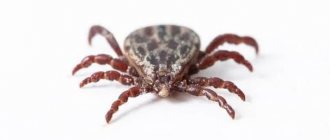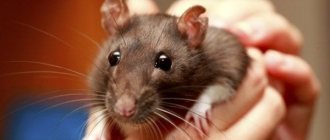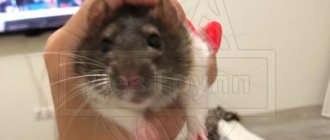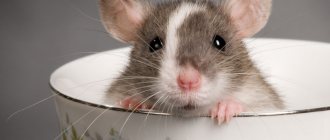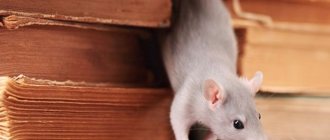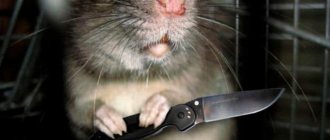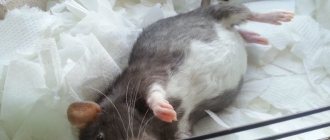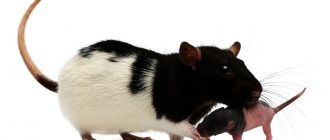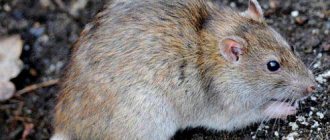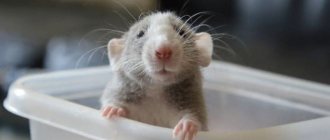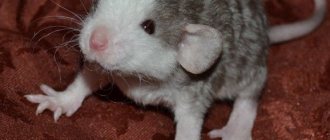Reasons why a rat may be choking or panting?
Attention! Due to the rapid metabolism of the decorative rat, diseases progress very quickly. It is impossible to identify them, much less cure them at home. Therefore, in case of any deviations in the breathing process, you must contact a veterinarian or, even better, a ratologist.
If extraneous sounds are heard during breathing (wheezing, whistling, etc.), it becomes confused or the animal is suffocating, this may be the cause of various diseases.
Respiratory diseases (bronchitis, pneumonia, asthma)
A rat's heavy breathing is a bad sign.
Sometimes even a common cold can cause more serious illnesses, resulting in death. For respiratory diseases, the following symptoms are distinguished:
— the rat constantly grunts and sneezes;
— dried brownish mucus appears on the nose and eyes, it is called porphyrin;
- a characteristic whistle is heard, the animal breathes frequently and unnaturally from its sides;
- there is a cough of varying intensity and humidity, wheezing and gurgling are heard when breathing, the rat opens its mouth;
- in neglected situations, the rat characteristically hunches its back, moves little and often sleeps;
- in severe cases of the disease, the rodent refuses to eat, apathy, ruffled fur, and mucous discharge from the eyes and nose are observed.
Have you noticed similar signs in your rodent?
Cardiovascular diseases (heart failure, heart attack, stroke)
Heart failure can occur in any rat, regardless of age. This disease also causes striking symptoms:
Is the rat grunting? Let's run to the vet!
— the animal gains weight sharply, a huge belly appears;
- sometimes the opposite situation occurs: the rodent quickly loses weight, the fur becomes dull and disheveled;
— the domestic rat loses activity, becomes easily fatigued, and the animal sleeps a lot;
— breathing becomes wet and heavy, the rodent grunts, wheezes and coughs;
- the tips of the animal’s tail and fingers become cold and blue, the hind legs are weakened.
Older, older rats may have a heart attack or stroke.
These diseases are characterized by the following symptoms:
- the animal falls on its side and convulses;
— the rodent opens its mouth and gasps;
- limbs move involuntarily.
Note: Cardiovascular and respiratory diseases may present with similar symptoms, but the treatment required is completely different. Therefore, it is impossible to diagnose and treat an animal on your own, without the help of a specialist.
If a rat is breathing heavily, this is not normal! https://youtu.be/
What sounds indicate health problems?
The owner of a decorative rat cannot always determine why his pet squeaks, so it is important to know what sounds should alert you and become a reason to examine your pet:
- A long, drawn-out squeal usually indicates that the animal is in pain. This could be a splinter in the paw, an abrasion received in a fight with fellow tribesmen, or other injuries. You need to carefully examine the rat and provide assistance.
- If the animal begins to wheeze, this may be a symptom of heart pathologies or pulmonary diseases. In cases where such a sound is accompanied by a deterioration in general condition, urgent veterinary care is needed.
- Sneezing and coughing, these phenomena indicate that the animal has a cold or has contracted a viral infection, which must be treated. With respiratory infections, in addition to these symptoms, there is lacrimation and lethargy.
So, having studied the ways in which rats transmit information, we can conclude that these animals are very emotional and sensitive to affection, aggression or danger. At the same time, each sound has its own meaning and should be considered in conjunction with the behavior of the animal. If you regularly observe rodents, you can easily learn to understand them.
Source
How to help a rat if it is panting, choking or grunting
Common causes of shortness of breath and breathing problems in rats are pneumonia and heart attack.
The most important thing to do is contact a veterinarian. Only a specialist can prescribe adequate treatment. If wheezing or other breathing problems occur, you can provide your pet with first aid and additional measures to the main treatment.
In case of a heart attack, when the animal is breathing heavily and making wheezing sounds, you must definitely pay attention to the tail and ears (they turn pale); fingers and tail tip (turns blue). Convulsions begin, the animal moves its limbs chaotically.
To provide first aid to the animal, you need to drop a few drops of Corvalol into the rodent’s mouth and rush to the veterinarian as soon as possible. Try to handle your pet as little as possible during an attack. In this state, he is capable of injuring your hand with a bite. Because of this, the animal may fall, which will further aggravate the situation. You should remove all unnecessary and traumatic objects (tunnels, ladders) from the cage. During an attack, the rat does not control itself and can injure itself.
Reference : pneumonia in rats is an infection that affects the animal’s lungs. Inflammatory processes occur in the rodent's respiratory organs.
If your rat is sneezing more than usual, listen carefully to the animal's breathing. In the case when the breathing is even, there are no mucous discharges from the nose, you just need to observe the behavior of the animal. You should not start treatment until you are sure that the animal is actually sick. The cause of sneezing may be a simple allergy or dust.
If the animal makes unnatural, grunting sounds, your rat is sick! Contact your veterinarian immediately!
Grunting sounds in the sinuses indicate that they are full and breathing is difficult . The disease progresses very quickly, so it is worth taking steps to consult a veterinarian. Based on the diagnosis, he will prescribe a course of antibiotics.
Important! You can become resistant to an antibiotic. Because of this, you will have to start all over again, but with a different, stronger medicine that can cause even more harm to the animal. Therefore, a clear diagnosis by a specialist is needed.
Ratologist will help save the rat
Measures to restore animal health
In order to cure your pet as quickly as possible, in addition to a course of antibiotics, it is necessary to take measures to restore the animal.
— The rodent’s cage must be reliably protected from drafts. — The room in which the cage is located should have normal air humidity . It should not be overdried.
— The cage should be thoroughly cleaned daily: the ammonia smell irritates the animal’s nose and breath.
— A heating pad installed in the cage also promotes recovery.
— Echinacea decoction will help strengthen the rat's immune system.
— If the pet is not alone, you need to seat the animals in different cages to prevent the spread of infection.
The rat snores when he sleeps
For beginner dog breeders
Aquarium equipment
What sounds do rats make and what does it mean?
Decorative rats are very popular pets. They are smart, playful and have a cheerful and easy-going disposition. In addition, these animals are very sociable and love to be the center of attention. Everyone knows that rodents make different sounds, but not everyone knows that each of them has a specific meaning. In order to better understand your pet, you need to learn to distinguish the features of these sounds; how to do this will be discussed further.
Elimination of consequences
The body was thrown away, but the smell remained. This situation happens if the stench has been present in the room for a long time. Materials were saturated - paper, fabric, wood. You will have to carry out a whole range of measures to put the house in order.
- open windows, doors, make a draft in the room so that the stinking aroma disappears faster;
- put the torn board back in place;
- send curtains, bedspreads, napkins - all fabric products for washing;
- Apply cleaning agent to carpets and vacuum thoroughly;
- Sprinkle a thick layer of soda on the floor, it draws out the smell from the wood well - leave for 1-2 hours, vacuum;
- add chlorine or a detergent containing it to the water, wash the floor - whiteness is excellent;
- A special composition is prepared for processing furniture. Add 1 teaspoon of liquid soap and 50 g of soda to 0.95 liters of hydrogen peroxide. Mix thoroughly and pour into a spray bottle or spray bottle. Treat the hard surface of furniture. After 60 minutes, remove the composition with a damp cloth.
At the final stage, you need to use an air freshener.
Gets rid of the dead rat smell
Traditional methods of neutralizing the unpleasant odor of rats
Rats often die under the floor; people have come up with many ways to kill the smell or eliminate it completely after removing the body.
- Fire. Light a torch and walk around the room with it, especially in the room where there was a rat under the floor. Instead of a torch, you can use incense sticks.
- Vinegar. Moisten a cloth generously and leave for 10-12 hours. Ventilate the room well.
- Potassium permanganate. Prepare a solution, treat the floor, furniture, walls.
- Lavender. If the house smells strongly, the aroma of lavender can cover the smell. You can use a plant, air freshener, essential oils.
Anti-odor medications
Odor neutralizers deal with persistent stench. Eliminates the smell of urine and feces after animals. Used to eliminate the smell of a dead rat.
The preparations do not contain aggressive components that can damage furniture. Can be used on different surfaces, including the upholstered part of a sofa and armchairs. Unlike conventional cleaning agents, detergents provide quick, complete elimination of stench.
The product has no pungent odors, does not cause an allergic reaction, and does not emit toxins during evaporation. It is very convenient to use, since it is sold ready-made, with a sprayer.
The most common brands:
- Biolife Safe @ Clean, Germany;
- OdorGone, USA, lavender scent;
- Fridge Balls, South Korea, unscented.
You can use any air freshener or product designed to neutralize pet waste.
Posts 1 page 16 of 16
Share12012-08-21 15:07:38
- Author: Coma white
- Participant
- From: Sevastopol
- Registered: 2012-08-12
- Invitations: 0
- Posts: 50
- Female gender
- Time spent on the forum: 15 hours 39 minutes
- Last visit: 2012-08-28 10:52:32
Hello. The problem I have is this: yesterday I took an adult rat (a boy) from my friends; his age is unknown, since he has been wandering from hand to hand all his life. They kept him poorly, they fed him with something unknown, and the last owners even believed that the rat did not need water, instead of bedding with newspapers. In general, the trouble is that the rat looks healthy outwardly, the only bad thing is that it grunts, similar to the sounds that guinea pigs make, especially when it eats or sniffs something. In general, I can’t take him to the vet yet. the next couple of days, what can be done during this time?
Treatment methods
The main goal of drug treatment for stroke in rats is to negate the negative consequences after the stroke has occurred and relieve inflammation from the cells.
Along with therapy, it is very important that the animal feels comfortable and is surrounded by care and proper care.
There is no single cure for the consequences of a stroke; it is a whole range of measures, including:
- Rehydration of the body - for this, a rehydration solution is administered.
- Anti-inflammatory drugs - to relieve inflammation in brain cells and tissues.
- Antiemetics - if after first aid it does not go away and the animal continues to vomit.
- Sedatives - help cope with disorientation.
- Antibiotics - to prevent the addition of a secondary infection, because The rodent's body is weakened after a stroke.
- Oxygen - to eliminate the effects of brain hypoxia.
- Corticosteroids provide comprehensive treatment to eliminate the severe consequences of a stroke.
- Diuretics - to prevent swelling.
Before starting treatment, the specialist must carry out a number of diagnostic measures that are aimed at establishing a diagnosis and the reasons that led to the disease.
For diagnostic purposes, a CT scan (computed tomography of the head) and an X-ray of the rat’s head can be used; these measures will help identify hematomas and/or tumors. An ophthalmoscopy examination will help identify disorders in the retina and signs of hypertension; these data are necessary for prescribing therapy.
After diagnosis and treatment, the animal is sent home; further care and rehabilitation depends on the owner of the animal.
The attending veterinarian decides how to treat a stroke in a rat; without the necessary knowledge, self-medication can harm the animal even more, which will lead to dire consequences.
Age-related heart rate norms
In adults, a normal rhythm is considered to be about 60-70 beats per minute. Below or above these limits is a warning about abnormalities in the body. Doctors consider a slow heartbeat - bradycardia - to be a more dangerous phenomenon. Rapid pulse - tachycardia, when the brain experiences a lack of oxygen. It compensates for the deficiency in two ways: by increasing blood pressure or increasing heart rate. Their frequency depends not only on external factors and chronic diseases, but also on a person’s hereditary predispositions.
Average value (beats per minute)
Standard boundaries depend on a person’s age, but we must not forget about individual characteristics. Anything higher is an increased heart rate. An adult is diagnosed with tachycardia when his pulse exceeds 90 beats.
Parasite infestation
A rat also sneezes when infected with skin parasites (fleas, lice eaters, ticks). This is accompanied by severe itching. Insect waste products cause a severe allergic reaction.
Fleas and lice eaters can be detected with the naked eye. To do this, you need to carefully examine the pet, parting the fur. As for ticks, this parasite is microscopic in size. It can only be detected with the help of a special analysis in a veterinary clinic.
If infected with parasites, the animal must be washed with pet shampoo. It is also useful to use Frontline or Bars spray.
Disorders of the larynx
If the vocal cords are inflamed or compressed by swelling, the voice sounds different than usual. Hoarseness and hoarseness may appear, and in some cases it may disappear altogether.
Inflammation of the larynx is called laryngitis. Laryngitis is usually of an infectious nature, predominantly viral.
Since viruses penetrate a hypothermic body more easily, laryngitis usually occurs after being outside for a long time in bad weather, as well as drinking iced drinks, ice cream, etc. In addition, the larynx can become inflamed as a result of overstraining the vocal cords. This often happens to teachers, announcers, presenters who are forced to speak loudly and for a long time.
Symptoms of laryngitis in adults and children:
- change in voice - hoarseness, hoarseness;
- sore throat, discomfort;
- labored breathing;
- wet superficial cough, attacks of which usually occur in the morning, after waking up;
- body temperature may increase slightly (usually does not reach 38C);
- general weakness, malaise.
- A change in voice can be caused not only by laryngitis, but also by other diseases of the larynx - papillomatosis, laryngeal syphilis, the formation of a benign or malignant tumor. If laryngitis does not respond to standard treatment within 7-10 days, consult a doctor.
Cough and sneeze
Cold symptoms in rodents and humans are very similar. The disease is manifested by coughing, sneezing, lacrimation, runny nose and apathy. When the first signs of respiratory diseases appear, your tailed pet should be shown to a veterinarian, since such diseases in rats develop very quickly and often cause death.
Sometimes healthy animals make sounds that vaguely resemble sneezing or coughing. They usually do this to intimidate their cagemates and to assume a leadership role.
How to deal with tachycardia
It is so laid down by nature that a person’s breathing and heartbeat are combined into a single center located in the brain. An increase in heart rate is always accompanied by shallow breathing. You just have to start breathing deeply with a pause while inhaling and exhaling, then after five minutes of this exercise the tachycardia will decrease and your well-being will improve.
Most doctors strongly recommend using medications for life, unless we are talking about some kind of emergency. But tablets for arrhythmia are a symptomatic treatment, and before prescribing drugs, it is recommended to first change your lifestyle.
In Soviet times, patients with tachycardia were often sent to sanatoriums for a long stay (from 3 to 6 months). The person rested, switched gears, and gradually the nervous tension subsided and the pulse returned to normal.
Now it is difficult to afford this form of treatment for most people, but medical centers offer a course of breathing exercises and calm physical exercises. Hiking, leisurely jogging, and swimming are also recommended. To cope with arrhythmia, doctors advise reviewing your diet.
You cannot sit at the table in an excited state.
Do not be distracted while eating: talking, watching TV, etc.
Not to mention, but to get up from the table with a slight feeling of hunger.
Limit the consumption of various stimulants: coffee (it should be reduced to 1 cup, and drink chicory throughout the day), tea, and other tonic drinks. Instead of traditional varieties of tea, use fireweed tea. It helps reduce agitation.
Reduce the consumption of alcohol, cigarettes, and better yet, get rid of bad habits forever to prolong your life.
To reduce the pulse, magnesium and potassium preparations are used - panangin, asparkam. They help the heart recover faster and are usually recommended for 1 to 2 months. It is useful to drink soothing infusions of medicinal plants.
